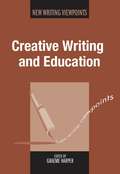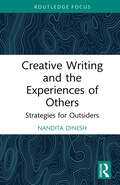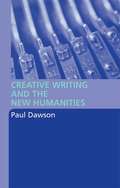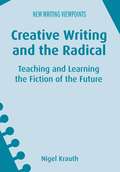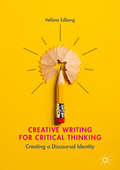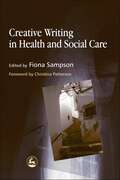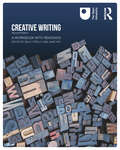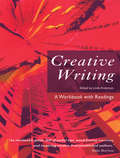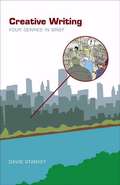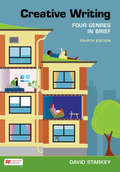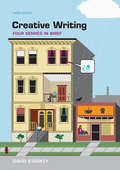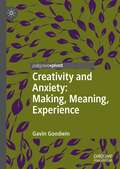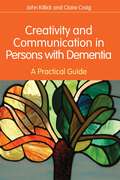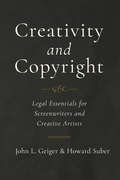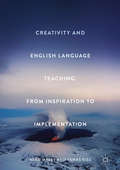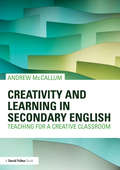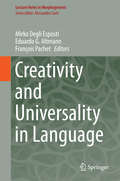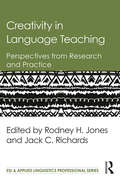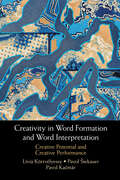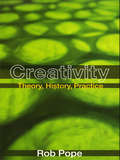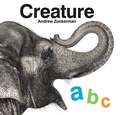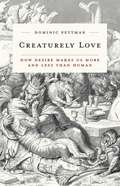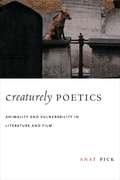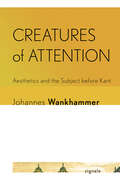- Table View
- List View
Creative Writing and Education
by Graeme HarperThis book explores creative writing and its various relationships to education through a number of short, evocative chapters written by key players in the field. At times controversial, the book presents issues, ideas and pedagogic practices related to creative writing in and around education, with a focus on higher education. The volume aims to give the reader a sense of contemporary thinking and to provide some alternative points of view, offering examples of how those involved feel about the relationship between creative writing and education. Many of the contributors play notable roles in national and international organizations concerned with creative writing and education. The book also includes a Foreword by Philip Gross, who won the 2009 TS Eliot Prize for poetry.
Creative Writing and the Experiences of Others: Strategies for Outsiders (Routledge Focus on Literature)
by Nandita DineshIn times that are rife with complex manifestations of identity politics, writing classrooms across the world are hosting heated debates about what it means for authors to write about experiences outside their own. This book focuses on writing as the act of witnessing when the writers themselves were not present to witness in person. It seeks to answer the questions that come along with these experiences, such as what might it mean to write in order “to watch,” “to try and understand,” “to never look away,” and “to never forget” when the writer is an outsider to an experience? What might it mean to write about others in ways that do not essentialize or sensationalize, and in ways that are as humble, ethical, and responsible as possible? What might it mean to bear witness through the written word while engaged in a constant (re)negotiation with one’s own positioning i.e., to cultivate a condition of critical empathy that doesn’t also have the consequence of creative paralysis?
Creative Writing and the New Humanities
by Paul DawsonThis book examines the institutional history and disciplinary future of creative writing in the contemporary academy, looking well beyond the perennial questions 'can writing be taught?' and 'should writing be taught?'.Paul Dawson traces the emergence of creative writing alongside the new criticism in American universities; examines the writing workshop in relation to theories of creativity and literary criticism; and analyzes the evolution of creative writing pedagogy alongside and in response to the rise of 'theory' in America, England and Australia.Dawson argues that the discipline of creative writing developed as a series of pedagogic responses to the long-standing 'crisis' in literary studies. His polemical account provides a fresh perspective on the importance of creative writing to the emergence of the 'new humanities' and makes a major contribution to current debates about the role of the writer as public intellectual.
Creative Writing and the Radical: Teaching and Learning the Fiction of the Future
by Nigel KrauthThe rise of digital publishing and the ebook has opened up an array of possibilities for the writer working with innovation in mind. Creative Writing and the Radical uses an examination of how experimental writers in the past have explored the possibilities of multimodal writing to theorise the nature of writing fiction in the future. It is clear that experimental writers rehearsed for technological advances long before they were invented. Through an in-depth study of writers and their motivations, challenges and solutions, the author explores the shifts creative writing teachers and students will need to make in order to adapt to a new era of fiction writing and reading.
Creative Writing for Critical Thinking: Creating a Discoursal Identity
by Hélène EdbergThis book explores narrative imagination and emotion as resources for learning critical meta-reflection. The author examines the learning trajectories of several students as they engage in learning to think critically through a new approach to creative writing, and details how learning through writing is linked to new discoursal identities which are trialled in the writing process. In doing so, she analyses the processes of expansion and change that result from the negotiations involved in learning through writing. This volume offers a completely new approach to creative writing, including useful practical advice as well as a solid theoretical base. It is sure to appeal to students of creative writing and discourse analysis as well as applied linguistics and language as identity.
Creative Writing in Health and Social Care
by Fiona Sampson'This book is really a must-have for therapists and others in the creative arts, so that you can see how the workings of the human mind can be displayed through the arts. Even with serious illness, the mind can talk. And that is the point of the book'. - Metapsychology Online Book Reviews 'The references cited at the end of each chapter are instructive and useful with some contributors drawing on memoirs and creative work and others on textbooks and papers. As Fiona points out in her introduction, those with an interest in the field - which includes clinicians, patients, arts managers, psychotherapists, writers, occupational therapists, teachers - I am sure you can add to the list - inevitably speak different languages, reflecting their different priorities. I agree with her argument that this contributes to a healthy diversity of practice that may offer "something for everyone" and we should resist narrow definitions. The challenge for those of us in the field is to locate ourselves on this strange and exciting map and to chart our own experiences in whatever languages are appropriate. Conferences, such as Strange Baggage and the increasingly popular Lapidus annual event provide an excellent opportunity to journey beyond our usual borders to exchange travellers' tales with our colleagues'. - Lapidus 'An incisive collection of essays and case studies, where theory is applied to practical goals: working out methods for how to help and understand those with problems threatening their sanity or stability. Creative expression can contribute to personal and community health.' - Writing in Education 'Creative Writing in Health and Social Care is full of experience of working with patients with dementia, hospital, hospice and occupational therapy patients, and those in primary care. This is innovative work - deeply helpful to the patients, illuminatively described.' - The British Journal of General Practice This unique and comprehensive 'map' of the topic of creative writing in health and social care brings together contributions from health and social care professionals and provides the information needed to teach, counsel and write. Principally exploring poetry and story writing and telling, case studies range from work with pre-literate children in post-war Macedonia to people with dementia in Britain. Complementing these insights, theory-based contributions provide context, comparing different arts therapies using psychoanalytic and phenomenological theories of art and ideas, assessing the value of creative writing in a health care setting, examining methods of training therapists and looking at the aims of creative writing in terms of self development. This holistic approach ensures that Creative Writing in Health and Social Care is an essential guide for health care professionals and others seeking to use creative writing in therapeutic settings.
Creative Writing: A Workbook with Readings
by Sally O’Reilly Jane YehCreative Writing: A Workbook with Readings provides a complete creative writing course: from ways to jump-start your writing and inspire your creativity, right through to presenting your work to agents and publishers. It covers the genres of fiction, poetry and life writing (including autobiography, biography and travel writing), combining discussions of technique with readings and exercises to guide you step by step towards becoming more adept at creative writing. The second edition has been updated and in large part newly written, with readings by a diverse group of contemporary authors displaying a variety of styles and approaches. Each chapter also features an array of inspiring writing exercises, enabling you to experiment with different methods and discover your strengths. Above all, Creative Writing: A Workbook with Readings will help you to develop your abilities while nurturing your individual voice as a writer.
Creative Writing: A Workbook with Readings
by Linda AndersonCreative Writing is a complete writing course that will jump-start your writing and guide you through your first steps towards publication. Suitable for use by students, tutors, writers’ groups or writers working alone, this book offers: a practical and inspiring section on the creative process, showing you how to stimulate your creativity and use your memory and experience in inventive ways in-depth coverage of the most popular forms of writing, in extended sections on fiction, poetry and life writing, including biography and autobiography, giving you practice in all three forms so that you might discover and develop your particular strengths a sensible, up-to-date guide to going public, to help you to edit your work to a professional standard and to identify and approach suitable publishers a distinctive collection of exciting exercises, spread throughout the workbook to spark your imagination and increase your technical flexibility and control a substantial array of illuminating readings, bringing together extracts from contemporary and classic writings in order to demonstrate a range of techniques that you can use or adapt in your own work. Creative Writing: A Workbook with Readings presents a unique opportunity to benefit from the advice and experience of a team of published authors who have also taught successful writing courses at a wide range of institutions, helping large numbers of new writers to develop their talents as well as their abilities to evaluate and polish their work to professional standards. These institutions include Lancaster University and the University of East Anglia, renowned as consistent producers of published writers.
Creative Writing: Four Genres in Brief
by David StarkeyHow can students with widely varied levels of literary experience learn to write poetry, fiction, creative nonfiction, and drama -- over the course of only one semester? In Creative Writing: Four Genres in Brief, David Starkey offers some solutions to the challenges of teaching the introductory creative writing course: (1) concise, accessible instruction in literary basics; (2) short models of literature to analyze, admire and emulate; (3) inventive and imaginative assignments that inspire and motivate.
Creative Writing: Four Genres in Brief
by David StarkeyCreative Writing: Four Genres in Brief offers concise, accessible instruction in the basics of writing poetry, fiction, creative nonfiction, and drama, providing short models of literature to analyze and emulate, plus inventive assignments to inspire and motivate you.
Creative Writing: Four Genres in Brief, 3rd Edition
by David StarkeyHow can students with widely varied levels of literary experience learn to write poetry, fiction, creative nonfiction, and drama -- over the course of only one semester? In Creative Writing: Four Genres in Brief, David Starkey offers some solutions to the challenges of teaching the introductory creative writing course: (1) concise, accessible instruction in the basics of writing poetry, fiction, creative nonfiction, and drama; (2) short models of literature to analyze, admire and emulate; (3) inventive and imaginative assignments that inspire and motivate. In the third edition, in response to reviewer requests, the literature and writing prompts have been significantly refreshed and expanded, while new treatment of getting published and the growing trend of hybrid creative writing have been added.
Creativity and Anxiety: Making, Meaning, Experience (Palgrave Studies in Creativity and Culture)
by Gavin GoodwinAnxiety is perhaps the defining psychological malady of our age, whereas creativity is seen as an almost unassailable good, its importance heralded and promoted in a range of disciplines and domains. A number of diverse thinkers and researchers have tried to unpick the relationship between anxiety and creativity, and this short book explores and connects some of their ideas and findings. Drawing on psychoanalysis and neuroscience, existential psychology and mindfulness, literary studies and philosophy, this book places a range of different disciplines in dialogue. It explores how creativity and anxiety might impact one another, and argues for the importance of establishing a diverse and inclusive cultural space which everyone can draw from and contribute to.
Creativity and Communication in Persons with Dementia
by Claire Craig John KillickProviding people with dementia with opportunities to engage in creative activity can play a crucial role in maintaining and enhancing communication, and in reinforcing personhood and identity. This thoughtful book describes how people with dementia, and the people who work with and care for them, can foster and develop a creative approach, and provides rich and varied ideas for creative activities. The authors explore the concept of creativity - what exactly it is, its particular relevance for people with dementia and how to get into the creative 'flow'. They introduce a range of creative art forms, including poetry and story-telling, collage, drama, music-making, photography, textiles and working with wood and metal, and suggest possibilities for employing them in a range of settings, and with people of all abilities. Consideration is given to the practicalities of facilitating such creative work, including how to organise and run sessions, how to involve people with dementia and their carers, and how to reflect upon the experience. Practice examples are included throughout the book, as well as the comments and observations of people with dementia, and many examples of the artwork and poetry the authors have created with people with dementia over the years. Brimming with ideas, suggestions and helpful guidance, this is an essential resource for all those who work with people with dementia, and an inspiring read for people with dementia and their families.
Creativity and Copyright: Legal Essentials for Screenwriters and Creative Artists
by Howard Suber John L. GeigerInspired by Strunk & White's The Elements of Style, this elegant, short reference is the perfect guide for screenwriters and creative artists looking to succeed as industry professionals. Readers will quickly understand the laws that govern creativity, idea-making, and selling, and learn how to protect themselves and their works from the legal quagmires they may encounter. Written by an unrivaled pair of experts, John L. Geiger and Howard Suber, who use real-life case studies to cover topics such as clearance, contracts, collaboration, and infringement, Creativity and Copyright is poised to become an indispensable resource for beginners and experts alike.
Creativity and English Language Teaching: From Inspiration to Implementation
by Alan Maley Tamas KissThis book offers a unique perspective on creativity in an educational environment where there is a relative dearth of literature on this subject. The authors link practice and principle to provide a practical and valuable guide for more creative language learning and teaching, using not only theoretical ideas but useful practical advice and recommendations on how better to introduce creativity into teaching and daily life. This innovative volume is sure to become a crucial reference point for teachers and practitioners of language teaching, and anyone interested in the ways in which creativity can be channelled into the teaching and learning process.
Creativity and Learning in Secondary English: Teaching for a creative classroom
by Andrew McCallumCreativity in secondary English lessons today is a democratically conceived quality that all pupils are expected to achieve and a resource on which all are entitled to draw. But what exactly is creativity? And how does it relate to English? Creativity and Learning in Secondary English answers these questions, and others, by arguing for a version of creativity that sees it as an ordinary, everyday part of successful classroom practice, central to processes of meaning-making, dialogic interaction and textual engagement. In this construction, creativity is not just linked to learning; it is the driving force behind learning itself, offering pupils the opportunity to transform their knowledge and understanding of the world around them. This book borrows from a range of theories about creativity and about learning, while remaining largely practical in focus. It contains numerous examples for teachers of how to apply ideas about creativity in the classroom. In doing so, it attempts to maintain the subject’s core identity while also keeping abreast of contemporary social, pedagogical and technological developments. The result is a refreshing challenge to some of the more mundane approaches to English teaching on offer in an age focussed excessively on standardisation and teaching to tests. Practical applications of creativity include: Using picture books and graphic novels to stimulate multimodal responses Placing pupils in the role of the teacher Devising marketing campaigns for class novels Adopting experimental approaches to redrafting Encouraging ‘extreme’ forms of re-creative writing Focusing on how to ‘listen’ to texts Creating sound-scapes for poems Thought-provoking and provocative, this textbook draws on current best practice in English teaching and will equip trainee and practising teachers with a wide range of strategies that will lead to greater creativity in the classroom.
Creativity and Universality in Language (Lecture Notes in Morphogenesis)
by Mirko Degli Esposti Eduardo G. Altmann François PachetThis book collects research contributions concerning quantitative approaches to characterize originality and universality in language. The target audience comprises researchers and experts in the field but the book may also be beneficial for graduate students. Creativity might be considered as a morphogenetic process combining universal features with originality. While quantitative methods applied to text and music reveal universal features of language and music, originality is a highly appreciated feature of authors, composers, and performers. In this framework, the different methods of traditional problems of authorship attribution and document classification provide important insights on how to quantify the unique features of authors, composers, and styles. Such unique features contrast, and are restricted by, universal signatures, such as scaling laws in word-frequency distribution, entropy measures, long-range correlations, among others. This interplay between innovation and universality is also an essential ingredient of methods for automatic text generation. Innovation in language becomes relevant when it is imitated and spread to other speakers and musicians. Modern digital databases provide new opportunities to characterize and model the creation and evolution of linguistic innovations on historical time scales, a particularly important example of the more general problem of spreading of innovations in complex social systems. This multidisciplinary book combines scientists from various different backgrounds interested in quantitative analysis of variations (synchronic and diachronic) in language and music. The aim is to obtain a deeper understanding of how originality emerges, can be quantified, and propagates.
Creativity and Writing: Developing Voice and Verve in the Classroom
by Kathy Goouch Andrew Lambirth Teresa GraingerThis clear yet authoritative book affirms the vital role of creativity in writing and considers and encourages flexible, innovative practices in teaching. Importantly, the book reflects upon teachers' imaginative and artistic involvement in the writing process as role models, collaborators, artists, and as writers themselves. Arguing that children's creative use of language is key to the development of language and literacy skills, this book focuses on the composition process and how children can express their own ideas. In addition, the authors consider the many forms of creative language that influence the inner and outer voice of children, including reading, investigating, talking and engaging in a range of inspiring activities. Illustrated throughout with many examples of children's writing and drawing, this book also provides suggestions for classroom activities and is a source of inspiration and practical guidance for any teacher looking to deepen their understanding of literacy theory and practice.
Creativity in Language Teaching: Perspectives from Research and Practice (ESL & Applied Linguistics Professional Series)
by Jack C. Richards Rodney H. JonesCurrent, comprehensive, and authoritative, this text gives language teachers and researchers, both a set of conceptual tools with which to think and talk about creativity in language teaching and a wealth of practical advice about principles and practices that can be applied to making their lessons more creative. Providing an overview of the nature of creativity and its role in second language education, it brings together twenty prominent language teachers and researchers with expertise in different aspects of creativity and teaching contexts to present a range of theories on both creative processes and how these processes lead to creative practices in language teaching. Unique in the field, the book takes a broader and more critical look at the notion of creativity in language learning, exploring its linguistic, cognitive, sociocultural and pedagogic dimensions. Structured in four sections— theoretical perspectives, creativity in the classroom, creativity in the curriculum, and creativity in teacher development—each chapter is supplemented by Questions for Discussion and Suggestions for Further Research. Its accessible style makes the book relevant as both a course text and a resource for practicing teachers.
Creativity in Word Formation and Word Interpretation: Creative Potential and Creative Performance
by Lívia Körtvélyessy Pavol Štekauer Pavol KačmárThere are many ways in which we, as speakers, are creative in how we form and interpret new words. Working across the interfaces of psychology, linguistics, psycholinguistics, and sociolinguistics, this book presents cutting-edge interdisciplinary research, showing how we manipulate the range of linguistic tools at our disposal to create an infinite range of words and meanings. It provides both a theoretical account of creativity in word-formation and word-interpretation, and an experimental framework with the corresponding results obtained from more than seven hundred participants. Data drawn from this vast range of speakers shows how creativity varies across gender and age, and demonstrates the complexity of relationships between the examined variables. Pioneering in its scope, this volume will pave the way for a brand new area of research in the formation and interpretation of complex words.
Creativity: Theory, History, Practice
by Rob PopeCreativity: Theory, History, Practice offers important new perspectives on creativity in the light of contemporary critical theory and cultural history. Innovative in approach as well as argument, the book crosses disciplinary boundaries and builds new bridges between the critical and the creative. It is organised in four parts: Why creativity now? offers much-needed alternatives to both the Romantic stereotype of the creator as individual genius and the tendency of the modern creative industries to treat everything as a commodity defining creativity, creating definitions traces the changing meaning of 'create' from religious ideas of divine creation from nothing to advertising notions of concept creation. It also examines the complex history and extraordinary versatility of terms such as imagination, invention, inspiration and originality dreation as myth, story, metaphor begins with modern re-tellings of early African, American and Australian creation myths and – picking up Biblical and evolutionary accounts along the way – works round to scientific visions of the Big Bang, bubble universes and cosmic soup creative practices, cultural processes is a critical anthology of materials, chosen to promote fresh thinking about everything from changing constructions of 'literature' and 'design' to artificial intelligence and genetic engineering. Rob Pope takes significant steps forward in the process of rethinking a vexed yet vital concept, all the while encouraging and equipping readers to continue the process in their own creative or 're-creative' ways. Creativity: Theory, History, Practice is invaluable for anyone with a live interest in exploring what creativity has been, is currently, and yet may be.
Creature ABC
by Andrew ZuckermanAn elegant addition to any library, this deluxe alphabet book features 120 pages of Andrew Zuckerman's breathtaking wildlife photography. From alligator to zebra, each featured animal boasts two striking studio portraits against a clean white background, offering a unique up-close view of the animal kingdom. Readers can flip to a helpful glossary in the back for extra information. From the sleek beauty of a smiling hippo to the powerful majesty of a roaring lion, this gorgeous new bookis both a stunning work of art and a ferociously fun way for young animal-lovers to learn their ABCs.
Creaturely Love: How Desire Makes Us More and Less Than Human (Posthumanities #42)
by Dominic PettmanTo our modern ears the word &“creature&” has wild, musky, even monstrous, connotations. And yet the terms &“creaturely&” and &“love,&” taken together, have traditionally been associated with theological debates around the enigmatic affection between God and His key creation, Man. In Creaturely Love, Dominic Pettman explores the ways in which desire makes us both more, and less, human. In an eminently approachable work of wide cultural reach and meticulous scholarship, Pettman undertakes an unprecedented examination of how animals shape the understanding and expression of love between people. Focusing on key figures in modern philosophy, art, and literature (Nietzsche, Salomé, Rilke, Balthus, Musil, Proust), premodern texts and fairy tales (Fourier, Fournival, Ovid), and contemporary films and online phenomena (Wendy and Lucy, Her, memes), Pettman demonstrates that from pet names to spirit animals, and allegories to analogies, animals have constantly appeared in our writings and thoughts about passionate desire.By following certain charismatic animals during their passage through the love letters of philosophers, the romances of novelists, the conceits of fables, the epiphanies of poets, the paradoxes of contemporary films, and the digital menageries of the Internet, Creaturely Love ultimately argues that in our utilization of the animal in our amorous expression, we are acknowledging that what we adore in our beloveds is not (only) their humanity, but their creatureliness.
Creaturely Poetics: Animality and Vulnerability in Literature and Film
by Anat PickSimone Weil once wrote that "the vulnerability of precious things is beautiful because vulnerability is a mark of existence," establishing a relationship between vulnerability, beauty, and existence transcending the separation of species. Her conception of a radical ethics and aesthetics could be characterized as a new poetics of species, forcing a rethinking of the body's significance, both human and animal. Exploring the "logic of flesh" and the use of the body to mark species identity, Anat Pick reimagines a poetics that begins with the vulnerability of bodies, not the omnipotence of thought. Pick proposes a "creaturely" approach based on the shared embodiedness of humans and animals and a postsecular perspective on human-animal relations. She turns to literature, film, and other cultural texts, challenging the familiar inventory of the human: consciousness, language, morality, and dignity. Reintroducing Weil's elaboration of such themes as witnessing, commemoration, and collective memory, Pick identifies the animal within all humans, emphasizing the corporeal and its issues of power and freedom. In her poetics of the creaturely, powerlessness is the point at which aesthetic and ethical thinking must begin.
Creatures of Attention: Aesthetics and the Subject before Kant (Signale: Modern German Letters, Cultures, and Thought)
by Johannes WankhammerCreatures of Attention excavates the early modern prehistory of our late modern crises of attention. At the threshold of modernity, philosophers, scientists, and poets across Europe began to see attention as the key to autonomous agency and knowledge. Recovering the philosophical and literary works from eighteenth-century Germany in which "attention," "subject," and "aesthetics" developed their modern meanings, Johannes Wankhammer examines control over attention as the cultural technique underpinning the ideal of individual autonomy. Aesthetics, founded by Alexander Baumgarten as a science of sense perception, challenged this ideal by reframing art as a catalyst for alternative modes of selfhood and attention. While previous scholarship on the history of attention emphasized the erosion of subjectivity by industrial or technological modernization, Wankhammer asks how attention came to define subjectivity in the first place. When periodically recurring crises of attention threaten the coherence of the subject, the subject comes undone at the very seams that first sutured it together. Creatures of Attention offers the first systematic study of a foundational discourse on attention from 1650 to 1780. Presenting pre-Kantian aesthetics as a critique of the Enlightenment paradigm of strained attention, the book offers a fresh perspective on poetics and aesthetics in eighteenth-century Germany.
